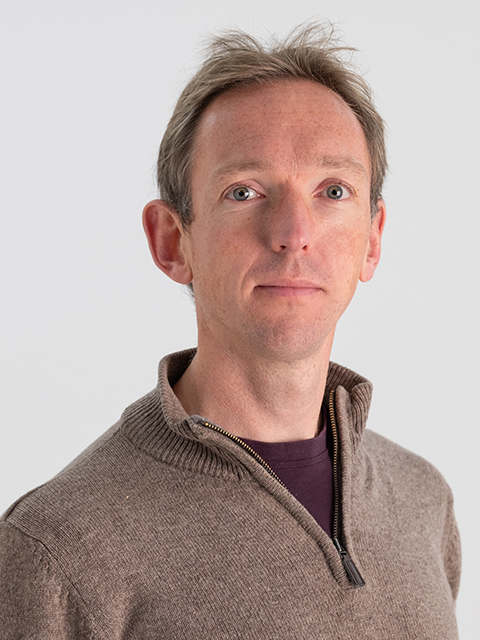Academic Career
- 2021-2024: NERC KE Fellow, multi-hazard risk
- 2021 - : Reader in Natural Hazard Risk
- 2018-2020: NERC KE Fellow, Insurance Sector
- 2010-2020: Lecturer & Senior Lecturer in GIS, Loughborough University
- 2008-2010: Catastrophe Modeller (Natural Hazards), Zurich Insurance Plc.
- 2005-2008: Bibby Research Fellow, St Catharine's College, Cambridge
Professional Responsibilities
- 2021 - : Executive Editor of EGU's Geoscience Communication
- 2019-2021: Associate Editor of EGU's Geoscience Communication
- 2016-2019: Editorial board of Heliyon (Elsevier)
- 2011-2016: Nuffield STEM (Science, Technology, Engineering and Maths) outreach Ambassador.
- 2010-2014: Programme committee member for Geomorphology section of EGU.
Prizes and Awards
- 2017: Loughborough University ‘Research Informed Teaching Award’
- 2012: Fellow of the Higher Education Academy
John is a geologist and physical geographer who uses numerical methods to model both the physics and statistics of active and Quaternary Earth processes. His aim is to gain fundamental insights into these processes, and to probabilistically quantify hazards and risk. His geomorphological work develops algorithms and novel methods, and typically provides the primary observational constraint in his work. In conjunction with the insurance industry, John's work on catastrophes aims to better understand the perils and methods to quantify them.
Current research interests include:
- The risk and hazard of weather extremes such as floods and storms, particularly co-occurring extremes and ‘catastrophe modelling’ (i.e. insurance sector analysis).
- Dynamics and mechanics of ice flow (e.g., how bedforms might allow ice sheets to flow faster)
- Oceanic volcanoes as laboratories of the interaction between deep Earth processes and extreme geomorphic events (e.g. floods)
John's teaching is mainly in the area of natural hazards, risk and catastrophe modelling. The hazards include floods, wind storms, storm surges, shrink-swell subsidence, cold and snow. The sub-topics he is particularly excited by include impact on networks (e.g. roads), critical infrastructure, and how the hazards may (or may not) be inter-related to each other in how they occur.
John is also involved in teaching Earth surface processes, field trips, and quantitative methods. He believes that integrating quantitative methods in pragmatic and interesting ways into learning allows students to become numerically confident and desirable employees.
Current Postgraduate Research Students
- Meaghan Dinney (2021 - ): Esker Morphogenesis
- Henry Wells (2021-): UNSEEN, most extreme, severe convective storms
- Josh Thompson (2021-): Evaluating physical climate risks to the financial sector
- William Norris (Oct 2022 -): Waterfalls, Hillslopes & Sediment: Understanding critical controls of landscape evolution
- Geoff Saville (April 2023 - , part-time): Multi-hazard impacts into holistic risk management and industry regulation on climate risk
- Sai Kulkarni (Oct 2023 -): Seeing extreme winds: Using video clips to quantify hazardous winds
Recent Postgraduate Research Students
- Paolo De Luca (2019) "Interacting UK Hazards – Impacts and Origins"
- Michael Walz (2018) "Hazard Uncertainty and related damage potentials of extra-tropical cyclones (HURD-ETC)"
- Corstanza Morinio (2018) "The hidden hazard of melting ground-ice in Northern Iceland"
- Chrisina Caballero (2018) "Critical coastal infrastructure and climate change adaptation"
- Benjamin Postance (2017) "Future climates - Understanding how the failure of engineered slopes impact UK transport networks"
- Wells, H, Hillier, J, Garry, FK, Dunstone, N, Clark, MR, Kahraman, A, Chen, H (2024) Climatology and convective mode of severe hail in the United Kingdom, Atmospheric Research, 309(2024), 107569, ISSN: 0169-8095. DOI: 10.1016/j.atmosres.2024.107569.
- Bloomfield, H, Hillier, J, Griffin, A, Kay, A, Shaffrey, L, Pianosi, F, James, R, Kumar, D, Champion, A, Bates, P (2023) Co-occurring wintertime flooding and extreme wind over Europe, from daily to seasonal timescales, Weather and Climate Extremes, 39, 100550, ISSN: 2212-0947. DOI: 10.1016/j.wace.2023.100550.
- Hillier, J. K. , Matthews, T., Wilby, R., Murphy, C. (2020) Multi-hazard dependencies can increase or decrease risk Nature Climate Change 10, 595–598
- Hillier, J. K., Benediktsson, I., Dowling, T., Schomacker, A., (2018) Production and preservation of the smallest drumlins, GFF, 140(2), 136-152 doi:10.1080/11035897.2018.1457714
- Mitchell-Wallace, K. Jones, M., Hillier, J. K., Foote, M. (2017) Natural catastrophe risk management and modelling: A practitioner’s guide. WileyISBN: 978-1118906040.
- Postance, B., Hillier, J. K., Dijkstra, T., Dixon, N. (2017) Indirect economic impact of landslide hazards by disruption to national road transportation networks; Scotland. Env. Res. Lett. 12 doi:10.1088/1748-9326/aa5555
- Hillier, J. K., Kougioumtzoglou, I. A., Stokes, C. R., Smith, M. J., Clark, C. D. (2016) Exploring explanations of subglacial bedform sizes using statistical models. PLoS ONE 11(7), e0159489, doi:10.1371/journal.pone.0159489
- Hillier, J. K., Macdonald, N., Leckebusch, G., Stavrinides (2015) Interactions between apparently primary weather-driven hazards and their cost. Env. Res. Lett. 10(10), 104003, doi:10.1088/1748-9326/10/10/104003
